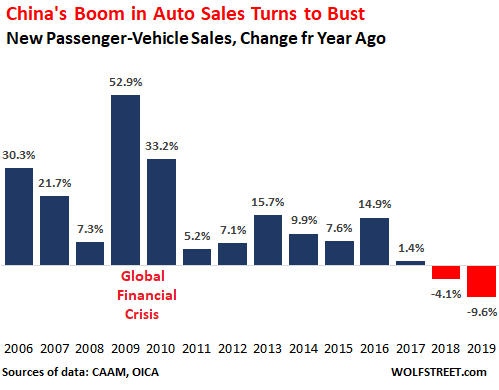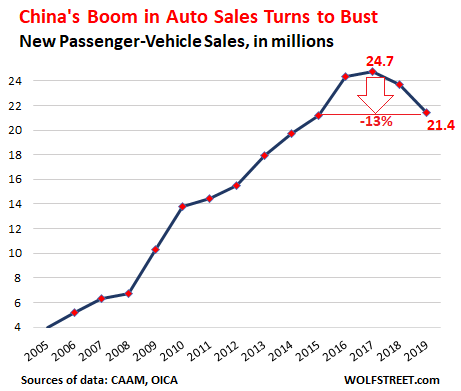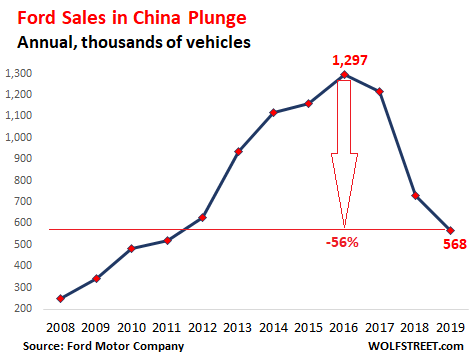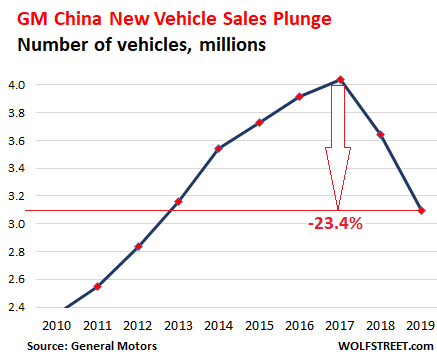“Challenging environment with weakened consumer demand”: This nosedive in a vast industry, affecting consumers and manufacturing, is happening even as GDP officially booms at 6%?
By Wolf Richter for WOLF STREET.
China’s market for new passenger vehicles, the largest in the world, turned into a mess in 2018, the first annual decline in the data going back about three decades, and then got messier. In December, passenger vehicle sales declined for the 18th month on a year-over-year basis, amid production cuts, layoffs, and plant closings. Particularly hard-hit were US automakers General Motors – second largest foreign brand in China – and Ford, which is just falling apart in China.
Sales of new passenger vehicles – this excludes commercial vehicles such as buses and commercial trucks – dropped 9.6% in 2019, according to data from the China Association of Automobile Manufacturers (CAAM) this morning. Note the huge surge in sales during the Financial Crisis, when the Chinese government threw enormous subsidies at retail customers. But not this time:

The CAAM, after consistently underestimating the decline for the past two years, said that it expects a 2% decline in total vehicle sales, which include commercial trucks and buses and which had been doing better than passenger vehicles. This would be the third year in a row of declines.
“We have moved away from the high-speed development stage. We have to accept the reality of low-speed development,” CAAM official Shi Jianhua told reporters.
Sales of passenger vehicles fell below 21.5 million units in 2019, but this still blows away US auto sales that have ticked down to 17.1 million units in 2019. China’s sales are now just above where they’d been in 2015. Over the two years, the decline amounted to about 13%:

Electrified-vehicle sales plunge in H2 after subsidies are cut further.
Back in 2018, the shining star amid the overall decline in vehicle sales that year was the category of “new energy vehicles” (NEV), which include battery EVs, plug-in hybrids, and hydrogen powered vehicles. In 2018, sales, powered by big subsidies had soared 62%.
NEV sales in 2019, after a strong first half, plunged later in the year as subsidies were cut, including a 27.4% year-over-year plunge in December, the CAAM said. And for the year overall, NEV sales fell 4% to about 1.2 million units. Because NEV sales fell more slowly than overall sales, their share of total passenger vehicle sales still rose to 5.9%.
Most of the NEVs are battery EVs; their sales ticked down 1.2% to about 972,000 units. Plug-in hybrid sales dropped 15% to 232,000; and hydrogen-powered vehicles amounted to less than a rounding error.
Ford got re-crushed in China.
Ford reported this morning that its sales in China plunged another 26.1% in 2019 from a year earlier to 567,854 vehicles, after a stunning 37% plunge in 2018. This was Ford’s third year in a row of sales declines. From its peak in 2016, with sales of nearly 1.3 million vehicles, and despite numerous turnaround strategies and promises of new products and whatnot, Ford’s China sales have now collapsed by 56% over the three-year period:

“2019 was a challenging year for the Chinese automotive market and for Ford in China,” Ford said in the announcement. Ford’s “value segment,” it said, was particularly impacted.
This time too, Ford recounted its rehash that it would “put more efforts into strengthening our product lineup with more customer-centric products and customer experiences to mitigate the external pressure.”
And it expects that “the pressure from the external environment and downward trend of the industry volume will continue in 2020.” In this respect, Ford appears to be in agreement with other automakers and with the CAAM: 2020 is going to be tough.
Here are some delectable morsels:
- Sales of imported vehicles plunged 32.7% to 10,861 units and now account for less than 2% of what Ford sells in China. Everything else is manufactured in China in joint ventures with Chinese partners.
- National Distribution & Services Division sales collapsed by 39.2% in 2019 to 253,499 units. These are largely the vehicles in Ford’s “value segment.”
- Lincoln sales dropped 15.7% to 46,629 vehicles.
- Jiangling Motors sales dropped 10.4% for the year to 236,222 vehicles
General Motors got battered.
GM isn’t quite a horrible shape in China as Ford is – but that doesn’t say much. It reported last week that its sales in China through its joint ventures plunged 15.1% in 2019, to 3.093 million vehicles, the second year in a row of brutal declines. Since its peak in 2017 of 4.04 million units, sales have plunged by 23.4%:

Despite the harsh declines, GM’s sales in China still exceed its US sales (2.89 million vehicles in 2019), and China remains GM’s largest market. But the comparison isn’t straightforward: In the US, the whole kit and caboodle is its own, and the US remains its most profitable market. But in China, GM manufactures and sells through joint-ventures with Chinese partners, including SAIC Motor, a state-owned enterprise and the largest automaker in China. The joint venture with SAIC manufactures Buicks, Chevrolets, and Cadillacs.
In its announcement last week, GM said that it also expects the “market downturn” to continue in 2020, that it anticipates “ongoing headwinds in our China business,” and pointed out the “challenging environment with weakened consumer demand.”
But luxury still sells. Consumers with plenty of money are still splurging, it seems. And GM’s luxury brand Cadillac was the standout in its report, with sales rising 3.9% in 2019 to a record 213,717 vehicles.
The Top Two Japanese Automakers Bucked the Trend.
Toyota and Honda both booked significant sales gains and market share gains in 2019, and luxury was hot, but the rest of the Japanese automakers weren’t so hot:
- Toyota Motor sales rose about 9% in 2019, to 1.62 million vehicles, with sales of Toyota-branded vehicles rising 8.4% to 1.42 million and sales of luxury-brand Lexus soaring 25% to 200,000 units.
- Honda sales – Honda and Acura combined – rose 8.5% to 1.55 million vehicles.
- Nissan did not disclose sales of its luxury brand Infiniti, but said that sales of Nissan-branded vehicles remained flat at 1.55 million units.
- Mazda sales fell 16% to 228,000 units
- Mitsubishi sales fell 7.6% to 133,000 units.
German luxury bands also booked gains.
Mercedes-Benz sales rose 6.2% to 693,443 vehicles in 2019, and became the #1 luxury brand in China. It said that more than three-quarters of the passenger vehicles its sells in China are built in China by its joint venture with BAIC Motor.
BMW sales grew 13% to 691,000 vehicles. A big hit was its redesigned crossover, the X3, built by its joint venture with Brilliance China Automotive, with sales exceeding 120,000 units.
Audi sales rose 4.1% to 690,100 units, but it wasn’t enough, and it fell off its perch as China’s #1 luxury brand that it had sat on through 2018. It’s now #3.
Audi’s parent Volkswagen Group remains the largest foreign automaker in China, but has not yet reported total sales for December and 2019.
These auto sales don’t portray a growing consumer economy. Luxury is doing well. But the numbers are small, and overall sales are now down for the second year in a row, by a combined 13%, in a market that could only grow before.
China’s auto industry weighs more heavily in China than the US auto industry in the US: The vast majority of vehicles that are sold in China are made in China. And the global component industry has resettled in China. China’s economy is still smaller than the US economy, but its auto industry is far larger. And this nose-dive in this vast industry that affects consumers and manufacturing is happening as GDP is officially booming at a rate of 6%? Something is amiss.